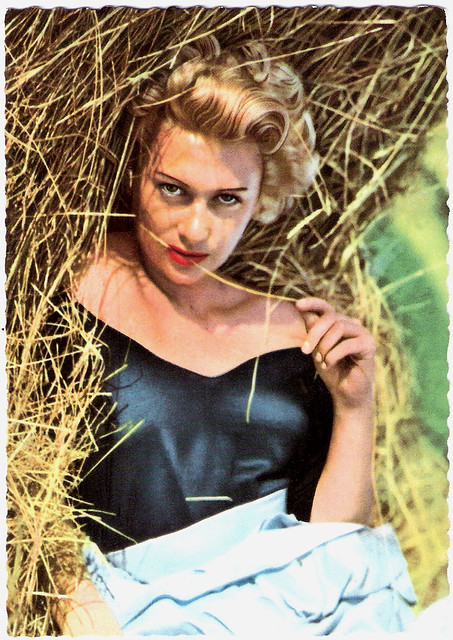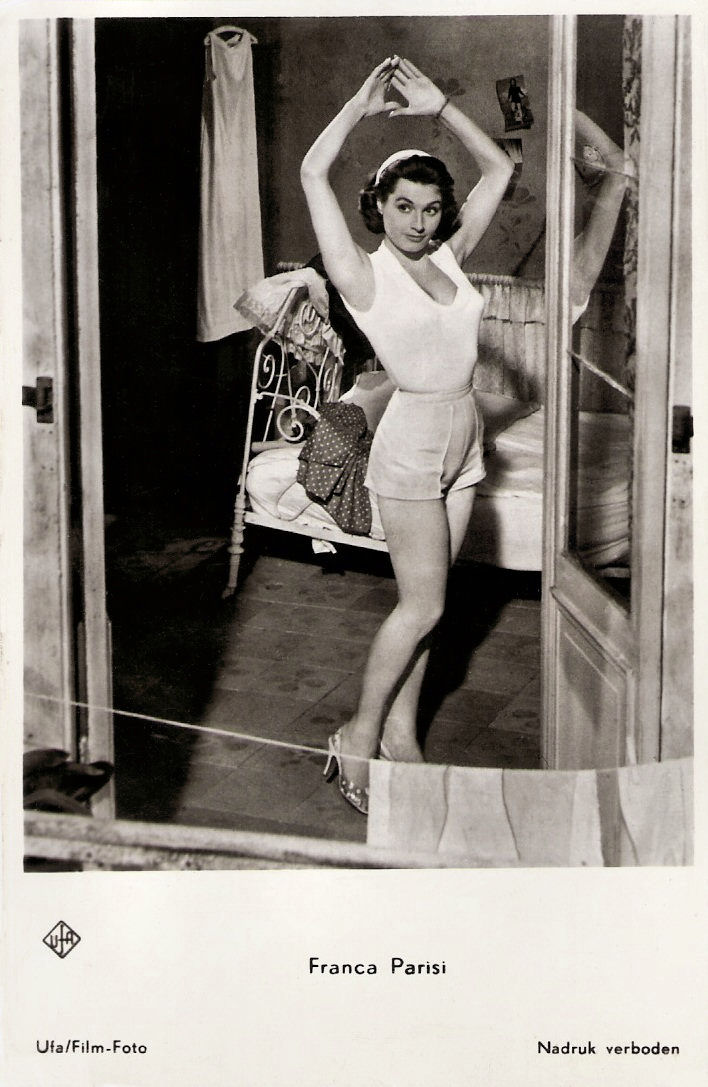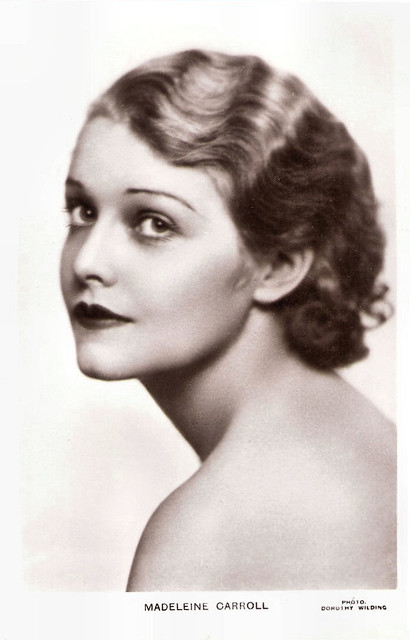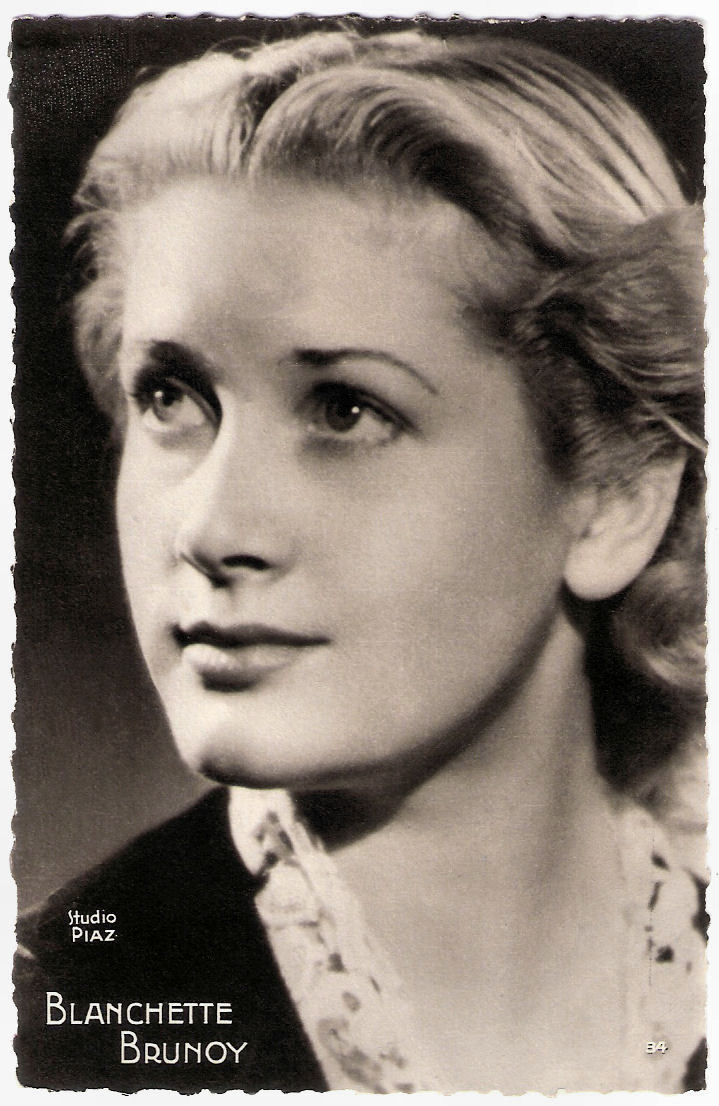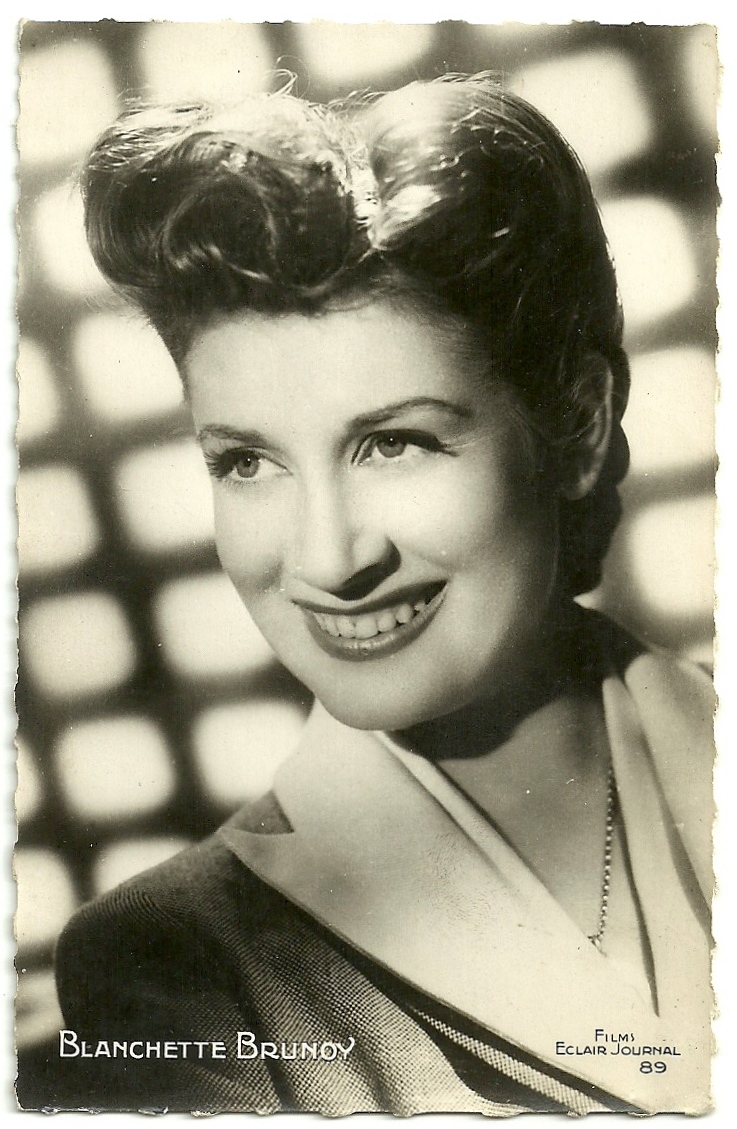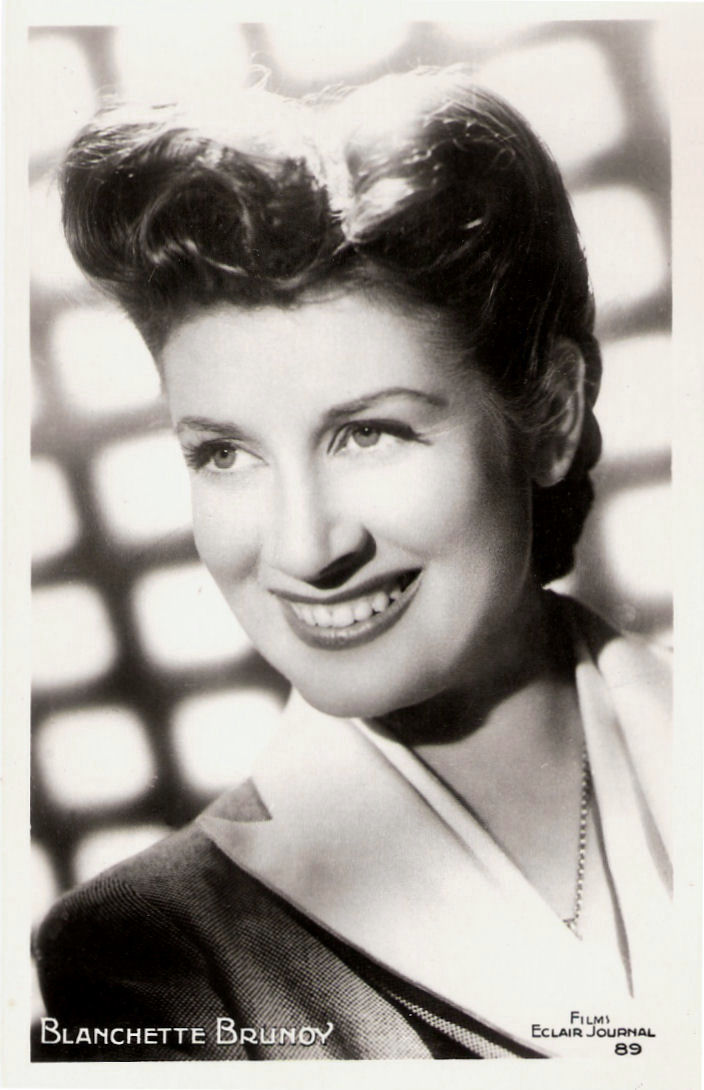Evelyn Laye (1900–1996) was one of England's most popular stars of musical revue and operetta during the 1920s. She did a few screen appearances in both London and Hollywood, including in the classic musical Evensong (1934).
Belgian postcard by S.A. Cacoa et Chocolat Kivou, Vilvoorde. Photo: Artistes Associès.
British postcard by A Real Photograph, no. 25 3151/2. Caption: "A Joyous Birthday. May this birthday bring along, Every joy for which you long."
British postcard by De Reszke Cigarettes, no. 21. Photo: Gaumont-British.
Elsie Evelyn Lay was born in Bloomsbury, London, in 1900. Her parents, Gilbert Laye and Evelyn Stewart, were both actors and Evelyn was already treading the boards at the age of two.
Her father managed the Palace Theatre in Brighton and this was where Evelyn first made a name for herself as Chinese servant Nang-Ping in Mr. Wu in 1915. Her London stage debut followed in 1916 in the revue Honi Soit at the East Ham Palace in 1916.
The first few years of her career she mainly played in musical comedy and operetta, including the aviation musical Going Up (1918-1919). She had her first West End success in 1920 with The Shop Girl, in which she was backed by a chorus of real guardsmen as she sang The Guards’ Parade.
Among her other successes during the 1920s were Phi-Phi (1922), Madame Pompadour (1923) - her first show for C.B. Cochran, Betty in Mayfair (1925-1926), Merely Molly (1926-1927), Blue Eyes (1928) and Lilac Time. Cochran called her ‘the fairest prima donna this side of heaven’.
In the cinema she made her debut in the British comedy thriller The Luck of the Navy (Fred Paul, 1927).
She married the comedian Sonnie Hale in 1926. Laye received widespread public sympathy when Hale left her for the actress Jessie Matthews in 1928. She subsequently wed actor Frank Lawton in 1934, with whom she remained married until his death in 1969.
In 1929, Evelyn Laye made her Broadway debut in the American première of Noël Coward's Bitter Sweet. Her song I'll See you Again became her trademark signature piece.
Her performance attracted the attention of film producer Samuel Goldwyn, who promptly brought her to Hollywood. She appeared in such early Hollywood film musicals as One Heavenly Night (George Fitzmaurice, 1931).
I.S. Mowis at IMDb: “The ridiculously contrived story and silly dialogue made this one of the worst flops of 1931, not helped by the wooden performance of Laye's co-star, John Boles. Although New York Times critic Mordaunt Hall, in his review reserved sole praise for Laye's singing and performance, Goldwyn washed his hands of the whole affair and Evelyn returned to England.”
British card.
British Raphael Tuck & Sons' Real Photograph postcard, no. 72. Photo: Gaumont-British.
Back in London, Evelyn Laye continued acting in pantomimes such as The Sleeping Beauty and Cinderella. She also appeared to great acclaim in the British film musicals Waltz Time (Wilhelm Thiele, 1933) co-starring Fritz Schulz, Princess Charming (Maurice Elvey, 1934) and Evensong (Victor Saville, 1934) with Fritz Kortner.
She did another film in Hollywood, the film operetta The Night Is Young (Dudley Murphy, 1935), with Ramon Novarro. But again without success.
During the second half of the 1930s, Laye was a ‘ravishing’ Helen of Troy in Helen!, appeared with the young John Mills in Give Me A Ring, co-starred with Viennese tenor Richard Tauber in Paganini, and returned to Broadway in 1937 with Jack Buchanan and Adele Dixon for Between The Devil. The show made history when it was presented for one night at the National Theatre in New York on the occasion of President Roosevelt’s birthday, thereby becoming the first American Command Performance.
She spent most of the war years as entertainments director of the Royal Navy, performing frequently for the troops. After the Second World War, she had less success, but in 1954, she returned to the West End in the musical Wedding in Paris.
She also acted several times opposite husband Frank Lawton, including in the TV sitcom My Husband and I (1956). Other stage successes included Silver Wedding (1957) with Lawton, The Amorous Prawn (1959) and Phil the Fluter (1969).
Later films include the horror film Theatre of Death (Samuel Gallu, 1967) starring Christopher Lee, the drama Say Hello to Yesterday (Alvin Rakoff 1970) as the mother of Jean Simmons, and the unsuccessful drama Never Never Land (Paul Annett, 1980) starring Petula Clark. She also did a good deal of television work.
Laye was awarded a CBE (Commander of the Order of the British Empire) in 1973 for her services to drama. One of her last plays was Noel Coward's Semi-Monde (1987-1988), at the Royalty Theatre in London, with fellow cast members Kenneth Branagh and Judi Dench.
At the age of 92, she made her farewell tour of Britain with the nostalgia show Glamorous Nights At Drury Lane, and received standing ovations. Later that year, she was paid a tribute at the London Palladium, led by actor John Mills
Evelyn Laye died in a nursing home in Pimlico, Central London from respiratory failure in 1996. She was 95.
British postcard in the Picturegoer Series, London, no. 871. Photo: Gaumont-British.
British Real Photograph postcard, no. 83. Photo: Metro-Goldwyn-Mayer.
Sources: I.S. Mowis (IMDb), AllMusic, Wikipedia, and IMDb.
Belgian postcard by S.A. Cacoa et Chocolat Kivou, Vilvoorde. Photo: Artistes Associès.
British postcard by A Real Photograph, no. 25 3151/2. Caption: "A Joyous Birthday. May this birthday bring along, Every joy for which you long."
British postcard by De Reszke Cigarettes, no. 21. Photo: Gaumont-British.
Going Up
Elsie Evelyn Lay was born in Bloomsbury, London, in 1900. Her parents, Gilbert Laye and Evelyn Stewart, were both actors and Evelyn was already treading the boards at the age of two.
Her father managed the Palace Theatre in Brighton and this was where Evelyn first made a name for herself as Chinese servant Nang-Ping in Mr. Wu in 1915. Her London stage debut followed in 1916 in the revue Honi Soit at the East Ham Palace in 1916.
The first few years of her career she mainly played in musical comedy and operetta, including the aviation musical Going Up (1918-1919). She had her first West End success in 1920 with The Shop Girl, in which she was backed by a chorus of real guardsmen as she sang The Guards’ Parade.
Among her other successes during the 1920s were Phi-Phi (1922), Madame Pompadour (1923) - her first show for C.B. Cochran, Betty in Mayfair (1925-1926), Merely Molly (1926-1927), Blue Eyes (1928) and Lilac Time. Cochran called her ‘the fairest prima donna this side of heaven’.
In the cinema she made her debut in the British comedy thriller The Luck of the Navy (Fred Paul, 1927).
She married the comedian Sonnie Hale in 1926. Laye received widespread public sympathy when Hale left her for the actress Jessie Matthews in 1928. She subsequently wed actor Frank Lawton in 1934, with whom she remained married until his death in 1969.
In 1929, Evelyn Laye made her Broadway debut in the American première of Noël Coward's Bitter Sweet. Her song I'll See you Again became her trademark signature piece.
Her performance attracted the attention of film producer Samuel Goldwyn, who promptly brought her to Hollywood. She appeared in such early Hollywood film musicals as One Heavenly Night (George Fitzmaurice, 1931).
I.S. Mowis at IMDb: “The ridiculously contrived story and silly dialogue made this one of the worst flops of 1931, not helped by the wooden performance of Laye's co-star, John Boles. Although New York Times critic Mordaunt Hall, in his review reserved sole praise for Laye's singing and performance, Goldwyn washed his hands of the whole affair and Evelyn returned to England.”
British card.
British Raphael Tuck & Sons' Real Photograph postcard, no. 72. Photo: Gaumont-British.
Princess Charming
Back in London, Evelyn Laye continued acting in pantomimes such as The Sleeping Beauty and Cinderella. She also appeared to great acclaim in the British film musicals Waltz Time (Wilhelm Thiele, 1933) co-starring Fritz Schulz, Princess Charming (Maurice Elvey, 1934) and Evensong (Victor Saville, 1934) with Fritz Kortner.
She did another film in Hollywood, the film operetta The Night Is Young (Dudley Murphy, 1935), with Ramon Novarro. But again without success.
During the second half of the 1930s, Laye was a ‘ravishing’ Helen of Troy in Helen!, appeared with the young John Mills in Give Me A Ring, co-starred with Viennese tenor Richard Tauber in Paganini, and returned to Broadway in 1937 with Jack Buchanan and Adele Dixon for Between The Devil. The show made history when it was presented for one night at the National Theatre in New York on the occasion of President Roosevelt’s birthday, thereby becoming the first American Command Performance.
She spent most of the war years as entertainments director of the Royal Navy, performing frequently for the troops. After the Second World War, she had less success, but in 1954, she returned to the West End in the musical Wedding in Paris.
She also acted several times opposite husband Frank Lawton, including in the TV sitcom My Husband and I (1956). Other stage successes included Silver Wedding (1957) with Lawton, The Amorous Prawn (1959) and Phil the Fluter (1969).
Later films include the horror film Theatre of Death (Samuel Gallu, 1967) starring Christopher Lee, the drama Say Hello to Yesterday (Alvin Rakoff 1970) as the mother of Jean Simmons, and the unsuccessful drama Never Never Land (Paul Annett, 1980) starring Petula Clark. She also did a good deal of television work.
Laye was awarded a CBE (Commander of the Order of the British Empire) in 1973 for her services to drama. One of her last plays was Noel Coward's Semi-Monde (1987-1988), at the Royalty Theatre in London, with fellow cast members Kenneth Branagh and Judi Dench.
At the age of 92, she made her farewell tour of Britain with the nostalgia show Glamorous Nights At Drury Lane, and received standing ovations. Later that year, she was paid a tribute at the London Palladium, led by actor John Mills
Evelyn Laye died in a nursing home in Pimlico, Central London from respiratory failure in 1996. She was 95.
British postcard in the Picturegoer Series, London, no. 871. Photo: Gaumont-British.
British Real Photograph postcard, no. 83. Photo: Metro-Goldwyn-Mayer.
Sources: I.S. Mowis (IMDb), AllMusic, Wikipedia, and IMDb.











